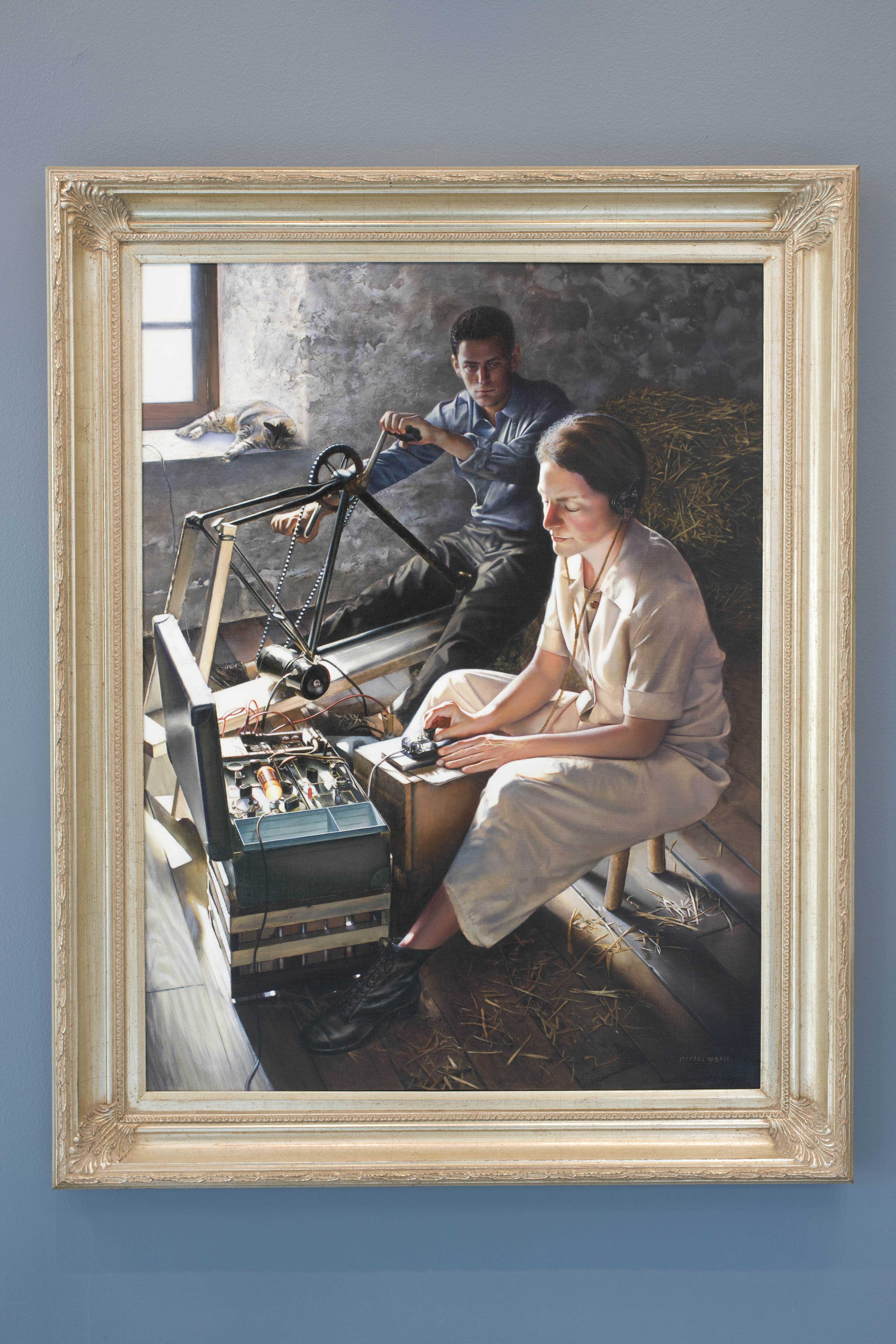Art Details

Virginia Hall was part of the OSS, a predecessor to today’s CIA.
by Jeffrey W. Bass
Oil on Canvas, 2006
Donated by Richard J. Guggenhime
When France fell under the Nazi boot in June 1940, Great Britain stood alone against the enemy. Fearing a similar fate for his country, Winston Churchill created the Special Operations Executive (SOE), an organization specializing in irregular warfare against German forces in occupied countries. SOE’s early recruits for espionage operations were from a variety of people from all classes, pre-war occupations, and countries – including a 35-year-old American woman by the name of Virginia Hall from Baltimore, Maryland. Hall had seen the Nazi devastation in France firsthand and was eager to do her part to defeat fascism. She underwent SOE’s rigorous preparation, remarkably, not because she was a woman, but because her left leg was made of wood, the result of a below-the-knee amputation necessitated by a pre-war hunting accident.
Fluent in French, Hall was sent to Lyon, France, in August 1941 where she helped develop the area’s newly born Resistance operation. Over the next 15 months working under cover as a journalist, Hall provided instructions, counterfeit money, and contacts to every British agent arriving in France. In addition, she was responsible for orchestrating supply drops and helping captured agents escape and make their way back to England. By November 1942, she had to use her own escape route out of France, just steps ahead of her pursuer, the now infamous Gestapo officer, Klaus Barbie, nicknamed “The Butcher of Lyon.”
By this time, the Americans had also created a paramilitary organization, the Office of Strategic Services (OSS). Hall transferred to the OSS and asked to return to occupied France. She hardly needed training in clandestine work behind enemy lines, and the OSS promptly granted her request, sending her to south-central France. Because her artificial leg kept her from parachuting in, she landed in Brittany from a British PT boat. As “Diane,” she eluded the Gestapo and contacted the Resistance. Often disguised as a milkmaid, she mapped drop zones for supplies and commandos from England, found safe houses, and linked up with a Jedburgh team after the Allies landed at Normandy. Hall helped train three battalions of Resistance forces to wage guerrilla warfare against German forces and kept up a stream of valuable reporting until Allied troops overtook her small band.
For her efforts in France, OSS chief General Donovan personally awarded Virginia Hall a Distinguished Service Cross – the only one awarded to a civilian woman during World War II. The medal is currently on display in the CIA Museum’s OSS Gallery. Hall later worked for the CIA, serving in many capacities as one of CIA’s first female operations officers.
The painting portrays Hall in the early morning hours, radioing London from an old barn near Le Chambon sur Lignon to request supplies and personnel. Power for her radio was provided by a discarded bicycle rigged to turn an electric generator, the clever invention of one of her captains, Edmund Lebrat. Using codes such as “Les marguerites fleuriront ce soir” (the daisies will bloom tonight), Hall was apprised of what airdrops to expect from London and when.
Art Specs
120 cm x 95 cm
(H x W)
Learn More
New Virginia Hall Interactive Exhibit
Virginia Hall: The Courage and Daring of “The Limping Lady”
The Debrief: Behind the Artifact – Virginia Hall Interactive Exhibit
The CIA Museum is committed to providing access to our history in as many ways as possible, so that our officers and our partners can learn about our mission and our people, amazing people like Virginia Hall. This tactile exhibit, a first of its kind here at CIA is a 3D rendering of our painting “Les Marguerites Fleuriront ce Soir” by artist Jeffrey Bass.
The painting depicts Virginia Hall sending a radio transmission from a barn in occupied France during WW2. Her prostatic leg “Cuthbert” as she called it, is shown near her radio. The CIA wanted to bring this painting to life for our officers or visitors who have low-sight or who are blind.
By working with the company 3D Photoworks we were able to create a 3D replica of the painting, where you actually set off sensors and hear audio descriptions and sound effects over the exact piece of the painting you’re now feeling. Shown here, Virginia Hall wears a high-top leather shoe that’s laced.. Buttons at the bottom of the painting explain how to use the tactile exhibit and give in-depth audio information about Virginia Hall’s early life, her service during WW2, her post-war life, and a detailed description of the painting. Used to transmit Virginia Hall’s messages in Morse code.
Our art normally has written labels people can see and read, but this interactive allows people with low or no sight the same opportunity to learn about Virginia Hall and this piece of art, though all of our users get more details now than they would from a label.
Being the CIA, we couldn’t just settle for buying audio of a radio transmission off the internet, so we reached out to former Office of Technical Service Officers who volunteered their time to actually recreate a transmission on a WW2 era radio. As she transmits her Morse code message to London….
Virginia Hall sent 37 messages from occupied France while serving with the OSS, this was an incredibly dangerous job, but just one of many dangerous jobs she did not just for the OSS, but for the SOE and the CIA.
She was chosen to be our first accessible painting for her bravery, her service, and because she’s an inspiration to those who have overcome challenges in life.
